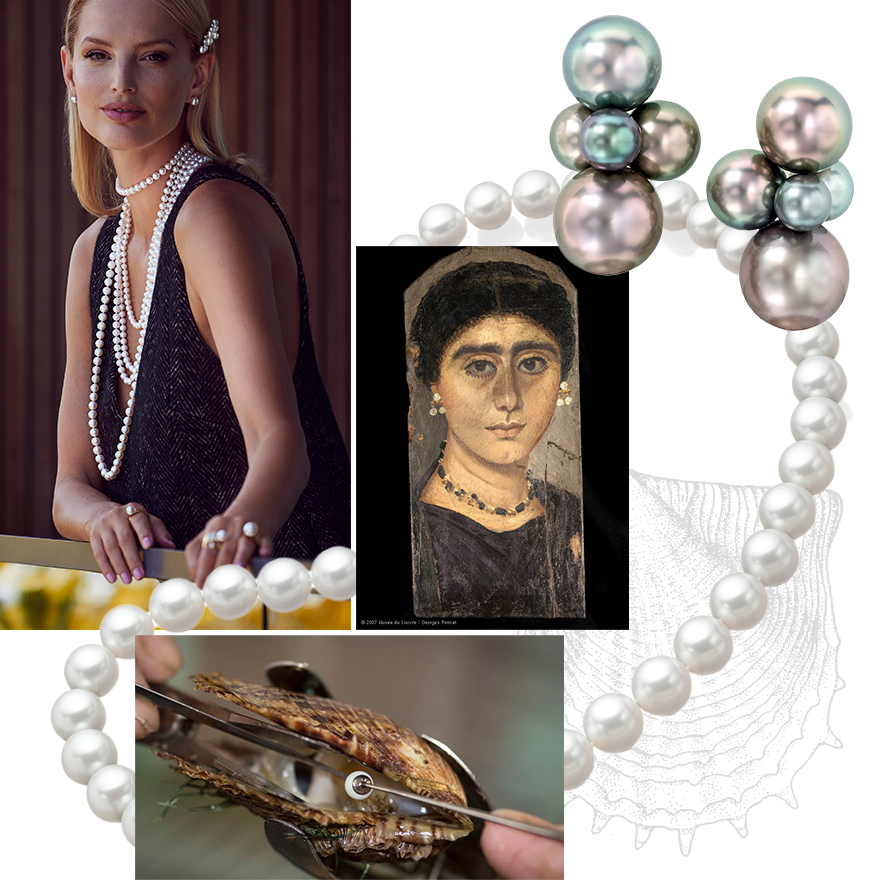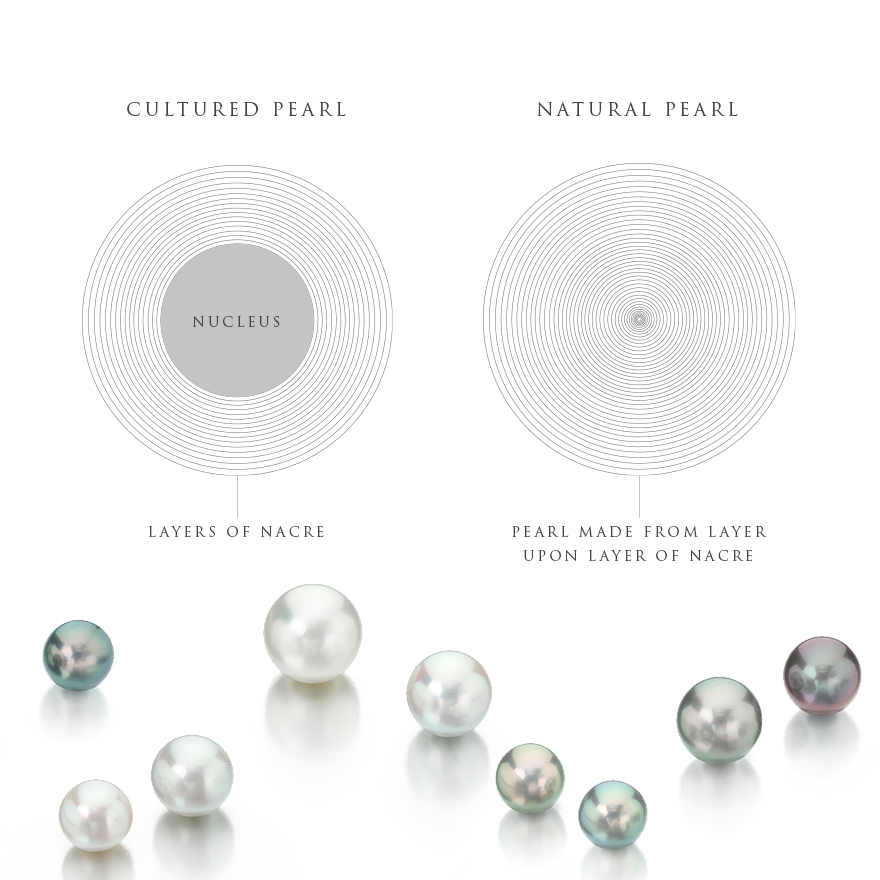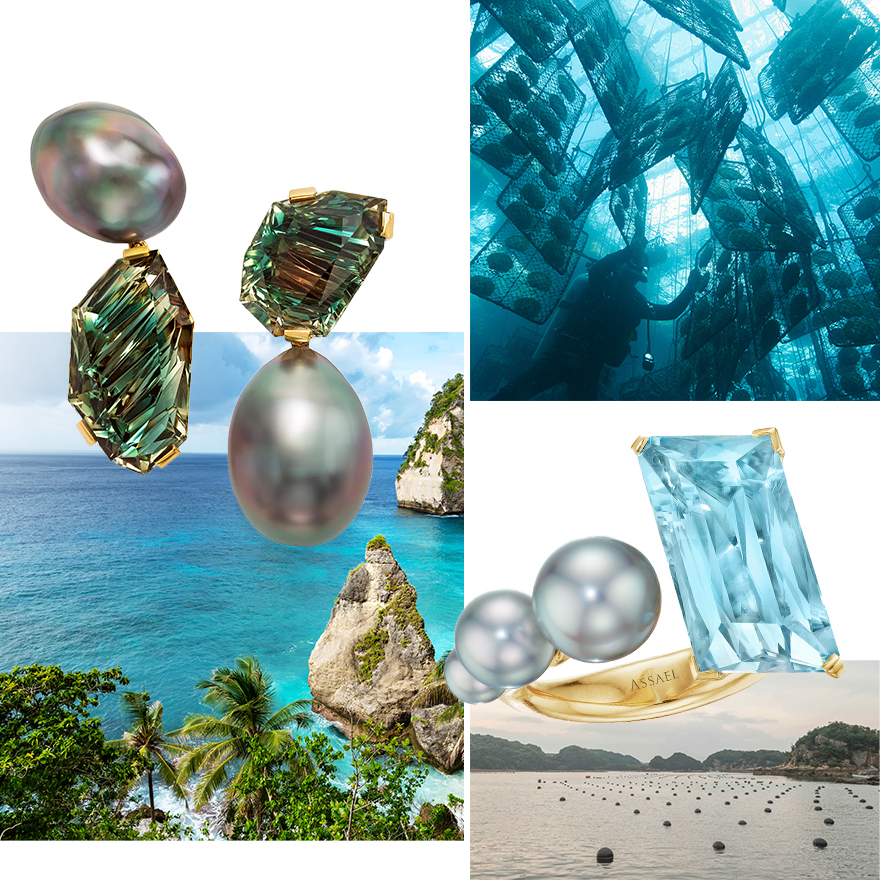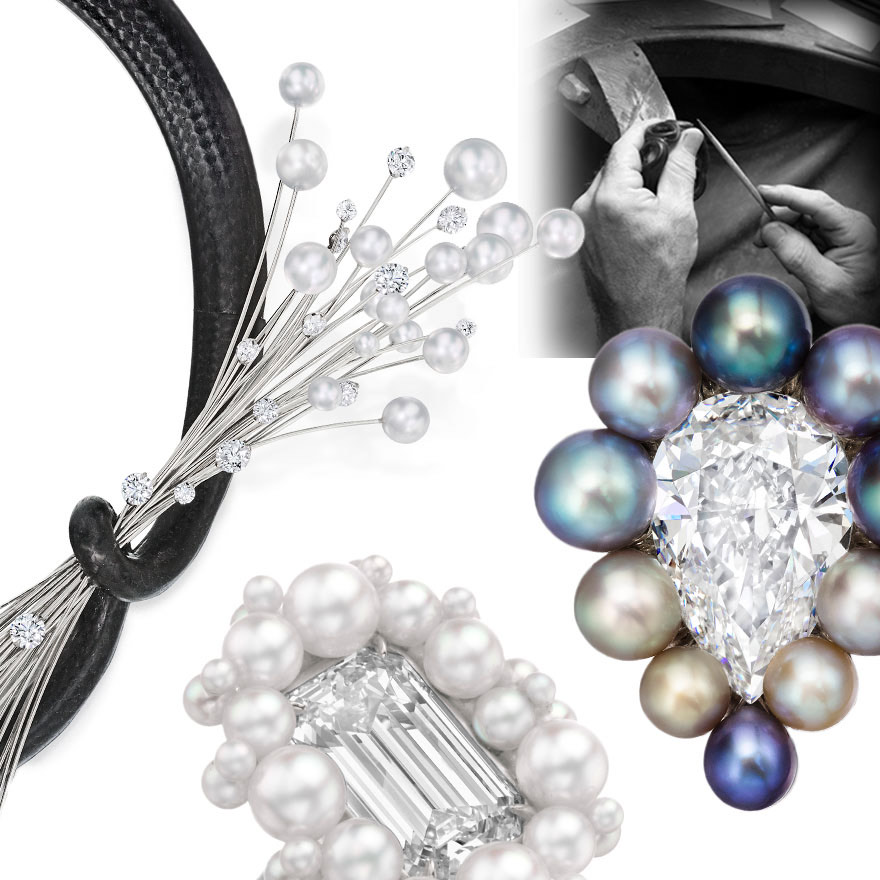
What is a Cultured Pearl?
Pearls have fascinated mankind and have been used as adornment for thousands of years. In fact, the first evidence of pearls being set into fine jewelry dates back to 5,800 B.C. The pearl’s beloved glow has always been cherished, making the pearl one of Nature’s most prized gems. In the contemporary world, pearls can be cultivated in a painstaking and expensive process that many people do not understand. Here, we will explore what a saltwater cultured pearl is in greater detail.
First, let’s start by defining the phrase “natural pearls.” Natural pearls are pearls that form within an oyster without any human intervention. These pearls are exceedingly rare. In today’s industrialized world, very few natural pearls are found, and it is extremely rare to find high quality natural pearls. Historically, natural pearls were enjoyed only by monarchs, the nobility, and the Maharajas because of their rarity. But since the early 20th century, human pearl farmers have been able to create “cultured pearls,” capitalizing on natural processes to make the distinctive beauty of pearls more available to fans and connoisseurs around the globe.
Cultured Pearls are started by man but grow in their natural process inside the oyster.

So, what exactly are cultured pearls? The term “cultured” in the designation of a “cultured pearl” simply refers to the fact that human beings started the process of pearl formation. Cultivating a pearl is often compared to artificial insemination or to fruit farming. As cultivated strawberries are truly strawberries, they are just not wild strawberries. Similarly, cultivated (cultured) pearls are real pearls, forming and growing in their natural habitat, protected and tended by pearls farmers.
In the case of cultured pearls, the cultivation process refers to a nucleus being inserted into the soft mantle tissue of an oyster by a highly trained pearl technician. Then, the oyster is put back into the ocean, and Mother Nature takes over, carrying out its natural processes. A pearl forms around the nucleus because the oyster wraps it with concentric layers of nacre, a natural substance that the oyster secretes. This completely natural process happens inside the oyster as it lives in its natural habitat, the ocean.
For more detail information about nacre, see our previous post What is Nacre?. For a more detailed explanation about how pearls actually form inside an oyster, see our Pearls of Wisdom post.
Almost all pearls are cultivated these days. While cultured pearls may be assisted by man in their creation, the process of pearl formation remains completely natural. The pearls grow inside the organism following the normal biological processes of the oyster.
Just because the process is natural, that does not make it easy. A great deal of time, effort, and precision is involved in cultivating saltwater pearls. After the nuclei are inserted into the oysters, those oysters must be cared for and cleaned and protected throughout the entire process of pearl formation which can take from 2 years to well over ten years. Typically, the longer the oyster stays in the ocean, the larger the pearl will grow. It is quite an investment for pearl farmers, both a labor of love and a risky financial endeavor. Only when the pearls are harvested do the farmers realize the value of their costly and painstaking efforts.
When properly cared for in clean ocean water, oysters can produce gem quality cultured pearls of spellbinding beauty and perfection. Because each pearl is unique, the process of matching the pearls (to form a strand, for example) can take even more time and requires extensive expertise. So, when you put all these factors together, you begin to realize what a miracle it is just to be able to hold a strand of South Sea Gem Pearls in your hands.
Cultured Pearls are one of the most sustainable gems on the planet.

Pearls are one of the only gems in the world formed inside living organisms, which classifies them “biogenic” gems. How precious or how valuable a pearl is will often be defined by the delicate conditions of the ocean environment in which the oyster lives. To sustain the oysters and keep them healthy during the years-long process of pearl cultivation, pearl farmers are diligent about keeping the ocean water as pure and clean as possible, no matter the cost, ensuring that the oysters have access to their natural food supply. Pearl farmers contribute to the health of the world’s oceans. So much so, that Departures magazine (the former publication for American Express Black Card holders) wrote in 2018, “Pearls just may be the most sustainable gems in the world. You see, oysters need pristine water conditions to produce high-quality pearls. Any decline in water quality, directly impacts oyster health, resulting in poorer pearl quality. … Thus, pearl farmers are naturally also stewards of the sea, in order to protect their investment.”
Pearl farming also leaves little waste. After pearls are harvested from the oysters, the oysters can often be re-used for growing another pearl. For those which are not re-used, the oyster meat is consumed by locals, and the shell is sold and/or used for decorative purposes (mother of pearl inlay, for example). The maintenance of the water and the lack of waste make pearls one of the most sustainable gems on the planet.
Types of Cultured Pearls – Akoya, South Sea, Golden South Sea, Tahitian, and Fijian Pearls

Cultured pearls can be grown in a wide variety of oyster species. The primary differences between the types of cultured pearls are due to the different oysters species and their different geographical areas.
The Pinctada Fukata is the smaller oyster species that lives off the coastal waters of Japan. This is the species used to grow Akoya Pearls. The color and distinctive luster of Akoya pearls is created by this particular genus of oyster. For more information on Akoya pearl, see our blog post What is an Akoya Pearl?
The Pinctada Maxima is the genus of oyster that lives in the South Seas near Australia, Indonesia, and the Philippines, hence the name South Sea Pearls. This is a larger oyster that can grow a much larger pearl. The oysters living off the coast of Australia tend to produce pearls in a variety of white shades – white, champagne, pinkish whites, etc. (Peggy are there official names for the various shades of white?). The same genus of oyster living nearer to Indonesia and the Philippines has yellow lip that creates sunny hues in its natural nacre, and therefore, produces Golden South Sea Pearls. For more information on South Sea Pearls, see our post Why are South Sea Pearls So Valuable and Why Are They a Great Gift. For more information on Golden South Sea Pearls, click here.
The Pinctada Margaritifera genus is a black-lipped oyster that lives in the Pacific waters around French Polynesia. This oyster produces Tahitian Pearls in wonderfully dark colors like charcoal and gray and often has colorful undertones like magenta or pistachio. For more information on Tahitian Pearls, click here.
The same genus (Pinctada Margaritifera) living off the coast of Fiji often exhibits a wider color range, and the Fijian pearls they produce come in a beautiful array of hues from chocolate brown to lagoon blue. For more information on Fijian pearls, click here.
Quality Factors of Cultured Pearls – Luster, Surface Cleanliness, Size, Shape, Color

Like diamonds, cultured pearls have various quality factors that affect their value, similar to the 4 C’s for buying a diamond. First and foremost is luster – the beautiful sheen or glow of the pearl. Nacre is what creates luster. The thicker the nacre, the higher the luster, and therefore, the higher value the pearl will have.
Surface cleanliness is another important value factor. A “clean” pearl refers to a pearl with no bumps, ridges, or cracks on its surface. The smoother and cleaner the surface of the pearl, the more the luster can be enjoyed and the higher the value.
Size can also affect a cultured pearl’s value. Pearls are measured by diameter in millimeters. Similar to diamonds and other precious gemstones, when all other quality factors are the same, the larger sizes are more valuable. Bigger pearls cost more to create because the oyster has to be left in the ocean and cared for during longer periods of time. Size can also be a very personal choice, based on fashion preferences or individual style. Some people prefer smaller pearls and others prefer larger pearls. It is important to choose a strand that suits one’s own sense of style.
Shape is another quality factor of pearls. Because cultured pearls grow in a natural process, as described above, their shape can be difficult to control. Perfectly round pearls are rarer and therefore more valuable. But irregular or non-round shapes, called “baroque” pearls are often beloved by pearl enthusiasts and collectors, especially larger sizes with high luster and gorgeous surface cleanliness.
Color can also affect the value of cultured pearls, but it can also be a very individual choice. In white pearls, most Western cultures prize pearls with subtle hints of pink hues. In Tahitian pearls, the multi-color “peacock” hues tend to claim higher prices. The good news is that thanks to cultured pearls, there are many colors to choose from, and one no longer needs to be a queen or a Rockefeller to enjoy wearing Nature’s most beautiful gifts from the sea.
For more information on the quality factors of cultured pearls, click here or here. For advice about how to shop for pearls, see our post on Pearl Shopping 101: 6 Things to Consider When Buying Pearls.
Feature image at top – clockwise from upper left – Elegance with Attitude campaign shot by David Benoliel model wears Assael Sunset necklace with 7 rows of Akoya pearls, Bubble pearl hair clips by Sean Gilson for Assael, Wrap rings by Sean Gilson for Assael, Tahitian Bubble pearl earrings by Sean Gilson for Assael, Assael South Sea gem pearl strand, painting from ancient Persia showing woman wearing layered pearls, cultured pearl being delicately extracted from an oyster
If you liked this, you might also like:
Akoya vs South Sea Pearls – How to Choose the Perfect Strand
Introduction to Pearls – Understanding Nacreous and Non-Nacreous Pearls
Why Are South Sea Pearls So Valuable? And Why Are They a Great Gift
Posted on Oct 24, 2024 in Pearl Education by emtaylor
Articles you may also enjoy
Join our Mailing List
Join us for magnificent pearl trends and exclusive treasures. Discover a world that is truly ... beyond rare.

Feeling inspired?
Consider this your invitation to the House of Assael. Find your closest luxury jeweler using our map search and start your journey to timeless elegance.




